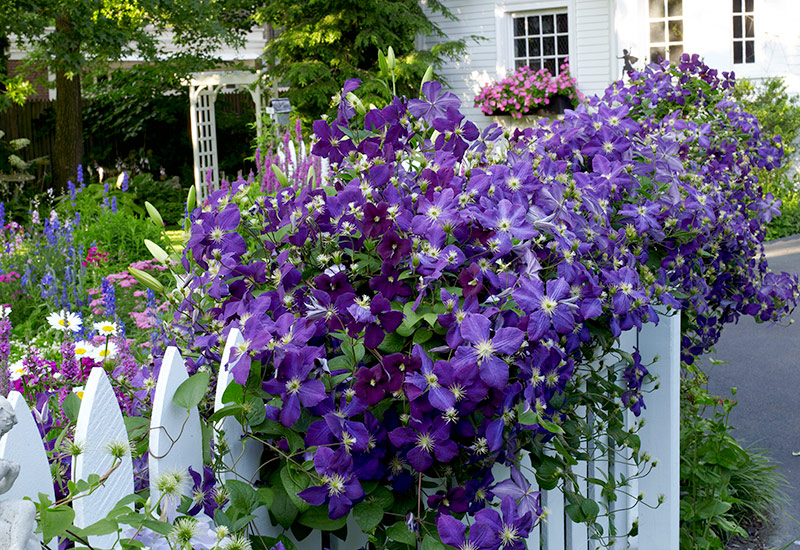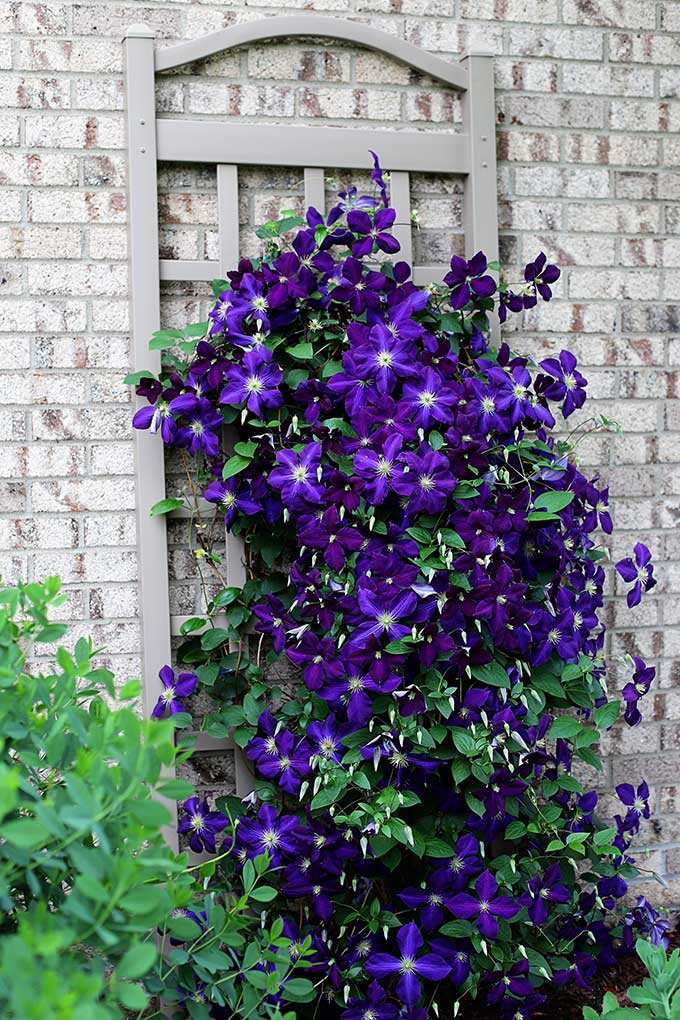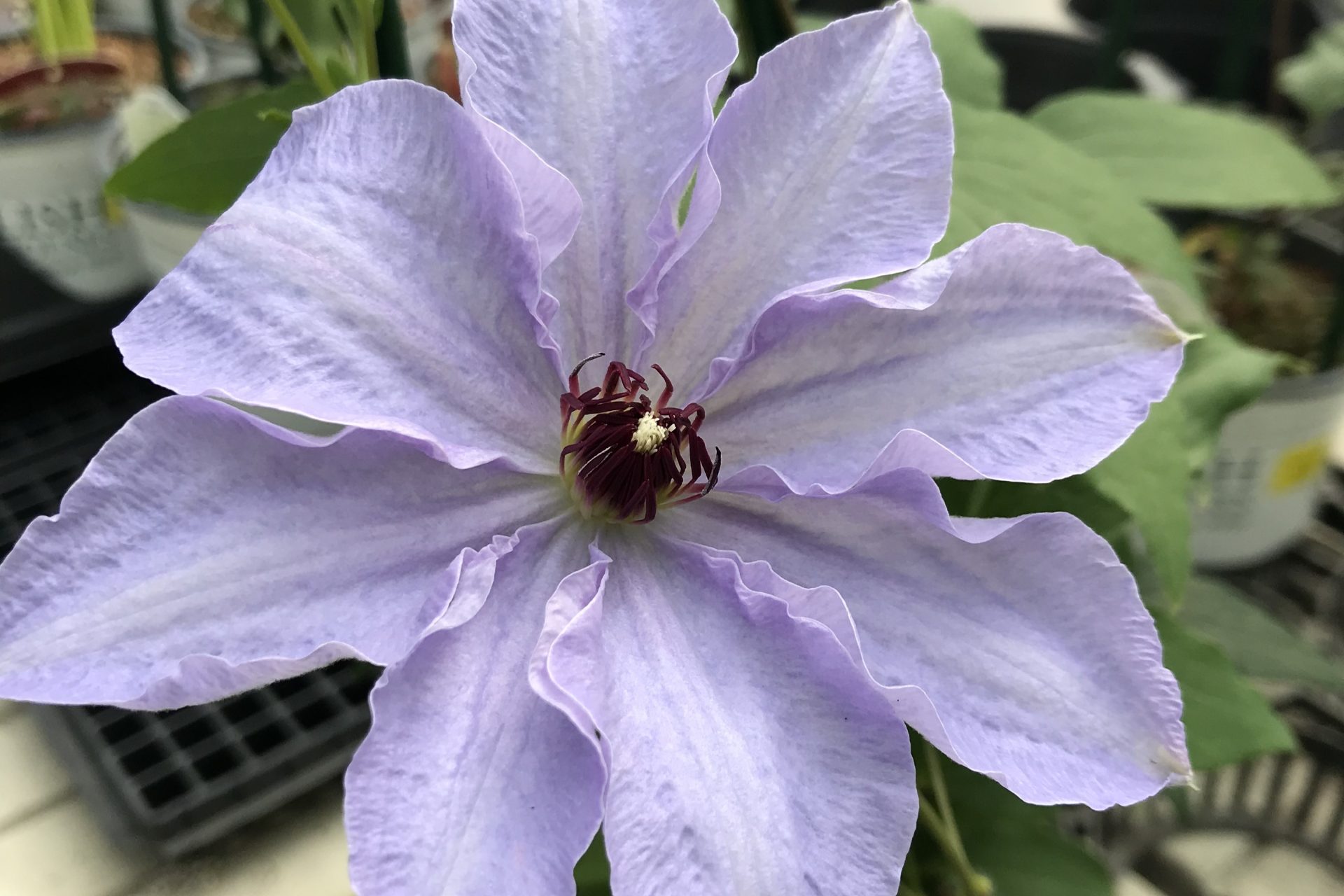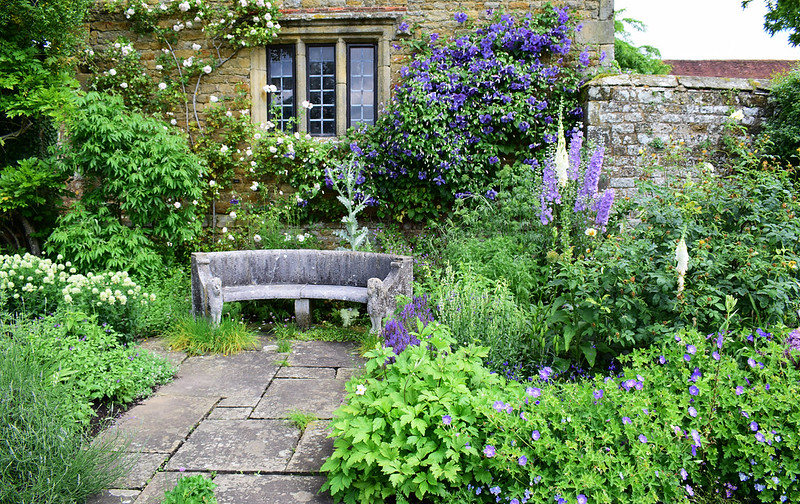
Sun Mar 17 - Written by: Ruth
10 Essential Clematis Care Tips for Thriving Blooms All Season
Learn essential clematis care tips to ensure your plants produce beautiful blooms throughout the growing season. Discover proper planting, pruning, and maintenance techniques for healthy clematis vines.
Few garden plants can match the dramatic impact of clematis, with its stunning flowers that can cover walls, fences, and trellises from spring through fall. Whether you’re drawn to the large, star-shaped blooms of ‘Jackmanii’ in deep purple or the delicate bell-shaped flowers of ‘Betty Corning’ in soft lavender, these versatile vines can turn an ordinary garden space into a showstopping display.
 Purple Jackmanii clematis climbing over a white picket fence, showcasing the dramatic impact these flowering vines can create. Source: Garden Gate Magazine
Purple Jackmanii clematis climbing over a white picket fence, showcasing the dramatic impact these flowering vines can create. Source: Garden Gate Magazine
But many gardeners struggle to get their clematis to bloom well, ending up with sparse flowers or sickly plants instead of the flowering wall they dreamed of. The good news is that with the right care techniques, anyone can grow these beautiful vines successfully.
In this guide, you’ll learn the 10 essential tips that will help your clematis thrive and produce abundant blooms throughout the growing season.
1. Pick Your Clematis Type
Clematis comes in three main groups. Group 1 flowers in early spring and needs little pruning. Group 2 gives you two bloom times – late spring and late summer. Group 3 blooms in late summer and is the easiest to care for. If you’re new to growing clematis, start with Group 3 varieties like ‘Jackmanii’ or ‘Ville de Lyon’. These plants grow well in most places and bounce back easily from mistakes.
 Different clematis varieties showcase the diversity of flower forms and colors available across the three pruning groups. Source: Gardeners’ World
Different clematis varieties showcase the diversity of flower forms and colors available across the three pruning groups. Source: Gardeners’ World
2. Find the Perfect Spot
Plant your clematis where the flowers get sun but the roots stay cool. Put the vine where it gets 6 hours of sun each day. Keep the roots cool by planting small flowers or placing flat stones around the base. The soil should drain well and have a pH between 6.5 and 7.0. Test your soil first, then add lime if needed to raise the pH.
 Proper clematis planting showing how to keep the roots shaded while allowing the vine to climb toward the sun. Source: House of Hawthornes
Proper clematis planting showing how to keep the roots shaded while allowing the vine to climb toward the sun. Source: House of Hawthornes
3. Plant It Right
Plant clematis in spring or fall when temperatures are mild. Dig a hole twice as wide and deep as the root ball. Mix compost into the soil you dug up. Plant the clematis 2-3 inches deeper than it was in its pot. This helps the plant grow new shoots if the main stem gets damaged. Water deeply and add 2-3 inches of mulch around the plant, keeping it away from the stem.
 Diagram showing the proper planting depth for clematis, with the crown buried 2-3 inches below soil level. Source: Gardening With Sharon
Diagram showing the proper planting depth for clematis, with the crown buried 2-3 inches below soil level. Source: Gardening With Sharon
4. Water With Care
Give new plants 1 inch of water each week. Stick your finger in the soil – if it’s dry 2 inches down, it’s time to water. Water at the base of the plant to keep leaves dry. Established plants need less water but don’t let them dry out completely. In hot weather, check the soil moisture every few days.
5. Feed Your Plants
Feed clematis with balanced fertilizer (like 10-10-10) in early spring when new growth starts. Feed again after the first flowers fade. Use half the amount listed on the package to avoid burning the roots. Too much nitrogen makes lots of leaves but few flowers. Spread the fertilizer in a circle around the plant and water it in well.
6. Prune Each Group Differently
Group 1: Cut only dead stems in early spring. Group 2: Remove dead stems in early spring and cut back stems with spent flowers. Group 3: Cut all stems to 12 inches above ground in late winter. Use clean, sharp pruning shears. Make cuts just above a leaf bud at a 45-degree angle.
 Detailed clematis pruning guide showing the different techniques required for each of the three clematis groups. Source: Wayside Gardens
Detailed clematis pruning guide showing the different techniques required for each of the three clematis groups. Source: Wayside Gardens
7. Watch for Problems
Check your plants weekly for signs of trouble. Clematis wilt makes stems turn black and collapse – cut affected stems back to healthy growth. Powdery mildew shows up as white powder on leaves – improve air flow and avoid wetting leaves when watering. Aphids and slugs can damage plants – wash aphids off with water and put crushed eggshells around plants to stop slugs.
8. Give Good Support
Put up a strong support before you plant. Clematis can’t climb by itself – it needs help. Trellises, fences, or poles work well. Make sure supports are at least 6 feet tall and firmly anchored. Guide new stems to the support and tie them loosely with garden twine. Check ties monthly and loosen any that get tight.
 Purple clematis climbing on a white trellis structure specifically designed to support the vine’s growth pattern. Source: Empress of Dirt
Purple clematis climbing on a white trellis structure specifically designed to support the vine’s growth pattern. Source: Empress of Dirt
9. Do Regular Upkeep
Spring: Clean up dead stems, add fresh mulch, and start fertilizing. Summer: Remove dead flowers to get more blooms. Watch for pests and diseases. Fall: Add thick mulch around roots for winter protection. Winter: Cut back stems based on your clematis group.
10. Plant Good Neighbors
Plant low-growing flowers near your clematis to shade its roots. Good choices include:
- Hostas: Their big leaves give good shade
- Lamb’s ear: Spreads to cover the ground
- Short daylilies: bloom at different times than clematis
 Beautiful mixed planting showing clematis growing alongside roses and other companion plants that provide shade for its roots. Source: Plant Addicts
Beautiful mixed planting showing clematis growing alongside roses and other companion plants that provide shade for its roots. Source: Plant Addicts
These plants help keep roots cool and stop weeds from growing.
By following these tips, you can grow clematis that blooms all season long. Start with the right plant in the right spot. Give it good care through the year. Soon you’ll have a beautiful vine full of flowers.
Remember that each garden is different. Watch how your clematis grows and adjust these tips to match your conditions. With time and practice, you’ll learn exactly what your plant needs to thrive.